Sprawling currant bushes quickly lose their shape without proper care. Overgrown plantings become an ideal breeding ground for fungi and insects. Lateral shoots left unpruned can grow so dense that they block sunlight from the central branches and reduce airflow throughout the bush. In this article, we’ll discuss summer pruning for currants, including whether red and white currants can be pruned and how to do it correctly.
Table of contents
Why Prune Currants in Summer
Black, white, and red currants belong to the Gooseberry family. These perennial shrubs are popular due to their low-maintenance nature and sweet-tart berries. In Europe, black currants are the most commonly grown, followed by red and white varieties.
The plants have either compact or spreading crowns depending on the variety, reaching heights of up to 1.5 m. Bushes grow vigorously for the first two years, then slow down and begin fruiting. The first harvest is usually gathered in the second year after planting, but peak productivity occurs at 5–6 years of age.
Currants bear fruit annually, yielding an average of 3–7 kg per bush. Red and white varieties ripen in late June, while black currants mature by mid-July. Pruning typically begins after harvesting, though debates about summer pruning persist.
Many gardeners believe summer pruning improves light exposure and airflow to the central shoots, promoting better growth of young side shoots. Others argue that weak shrubs should not be pruned in summer, as it may slow vegetative growth and shift energy toward generative development.
Purposes of Pruning

Summer pruning helps redirect shoot growth. This keeps bushes neat and attractive while ensuring larger, sweeter berries.
Gardeners decide for themselves whether to prune in summer or wait until autumn. However, currants tolerate pruning well. Proper shaping helps prevent fungal diseases and maximizes yield.
Neglecting pruning leads to overcrowding, with dead branches blocking light and air. This results in smaller berries, fewer flowers and fruit sets, and premature aging of the bushes.
Formative and rejuvenating pruning is best done in spring or autumn. During these seasons, diseased, damaged, and spent branches are removed, and future growth is directed. Autumn pruning should occur after leaf fall.
It’s crucial to allow nutrients from older branches to flow back into the root system. The plant will rely on these reserves during winter.
When to Prune
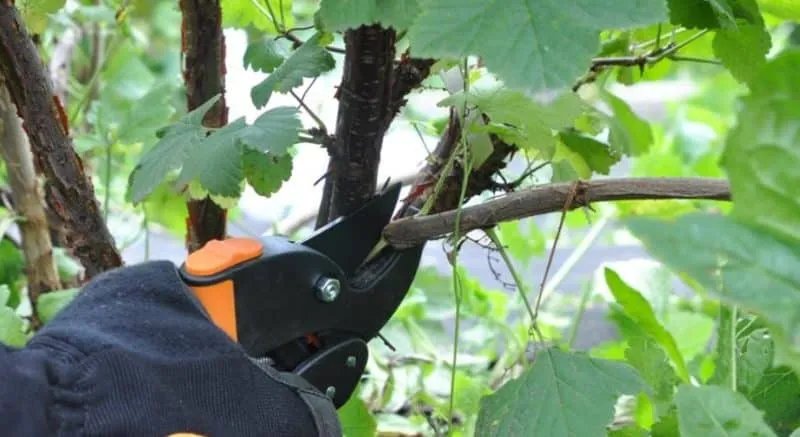
Experienced gardeners recommend performing only light sanitary pruning after harvesting. There are no strict deadlines—timing depends on regional climate conditions.
Note. Prune on dry, sunny days. Dry branches are easier to cut.
General pruning periods after fruiting range from July to September. In southern Europe, pruning can begin in mid-June to early July, while in northern and central regions, August is ideal.
Optimal Days
Those who follow lunar gardening principles may consult a lunar calendar for guidance.
How to Prune Currants Correctly
When pruning currants in summer, use sharp, sanitized tools and follow a systematic approach to branch removal.
Required Tools
Always disinfect pruning tools to prevent fungal infections.
Essential equipment includes:
- Pruning shears (secateurs) for young growth;
- Loppers for thicker branches;
- A knife for refining uneven cuts;
- A rake for collecting trimmings;
- Disinfectants such as rubbing alcohol, vodka, kerosene, or a 3% copper sulfate solution.
Step-by-Step Pruning Guide
Pruning technique:
- Remove all diseased, old, moss-covered, dry, or damaged branches, especially those over 4–5 years old.
- Cut back branches that sag or touch the ground—they receive little sunlight and produce poorly.
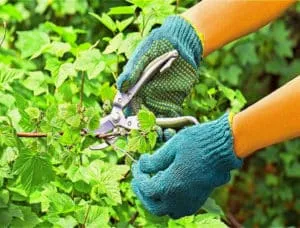
- Shorten new replacement shoots by one-third above a bud to encourage branching.
- Renew 2–3-year-old branches: remove weak side shoots with few buds to strengthen remaining growth.
- Trim the tips of young growth on 2–3-year-old branches to promote bushiness.
- Shorten secondary branches longer than 40–50 cm.
- Remove inward-growing shoots to prevent overcrowding.
A black hole in a cut branch indicates currant borer infestation—remove the entire shoot.
Differences in Pruning Black, Red, and White Currants
Red and white currants have similar growth and fruiting patterns. Their oldest productive branches are 7–8 years old, with peak yields at 5 years. Formative pruning is best done in late July after harvesting.
Pruning red currants involves:
- Removing inner shoots that shade fruiting branches;
- Cutting old branches back to strong lateral shoots;
- Trimming ground-level shoots (these can be layered for propagation);
- Eliminating damaged or diseased wood.
A well-shaped red currant bush should have 15–25 branches aged 1–8 years.
Black currants require a different approach, as most fruit grows on two-year-old wood. Remove branches older than 5 years and pinch back annual stems. Some gardeners combine shaping and sanitary pruning.
Note. Late black currant varieties fruit in August, so pruning is delayed until September–October.
Avoid heavy tip pruning on black currants—it reduces yields. This technique is acceptable for red and white varieties.
Age-Specific Considerations
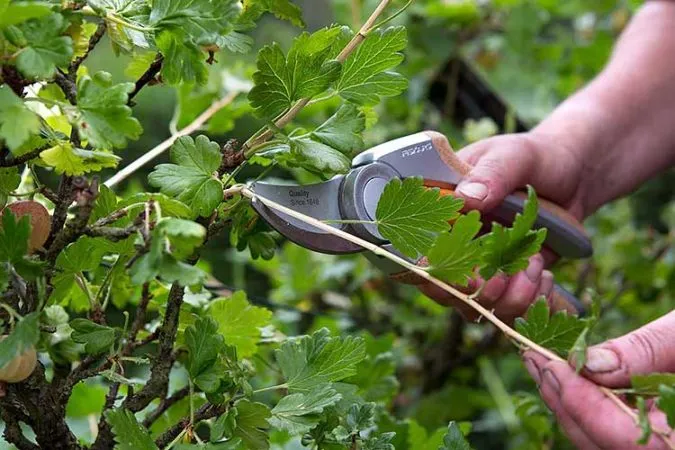
Currants find pruning stressful. Ragged cuts force the plant to expend energy healing, so always use sharp tools.
Pruning by age:
- At planting, cut all branches back to 4 buds above soil level. This encourages 4–8 new shoots the following year.
- After one year, pinch back all young shoots by one-third above a bud.
- At two years, pinch back new ground shoots and trim skeletal branches. Remove weak side growth, leaving only strong shoots with multiple buds.
- At three years, thin out overcrowded growth.
- From year four onward, remove aging wood annually. Cut old branches at the base and shape remaining growth as for three-year-old plants. Retain 3–6 new replacement shoots yearly.
Post-Pruning Care
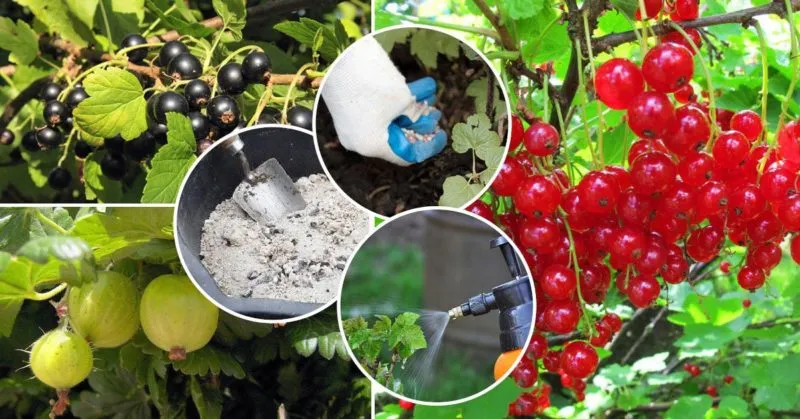
Currants thrive with consistent moisture, directly impacting yield. During fruiting, they need ample water. Drought causes small, dropped berries. Water at the base every 10 days in dry weather, using 50–60 L per bush. Avoid overhead watering to prevent powdery mildew.
After watering, loosen soil gently to aerate roots. Currants have shallow roots—take care not to damage them. Mulch with straw, hay, or peat (6–8 cm deep) to retain moisture and suppress weeds.
After summer pruning, feed with phosphorus and potassium (70–100 g phosphorus, 30–50 g potassium, or 100–300 g balanced fertilizer per m²). Apply compost or manure every three years (10 kg per bush). Urea solution (3 matchboxes per 10 L water per bush) is highly effective. For bushes over four years, reduce urea to 25–30 g, applied twice at two-week intervals.
Expert Tips
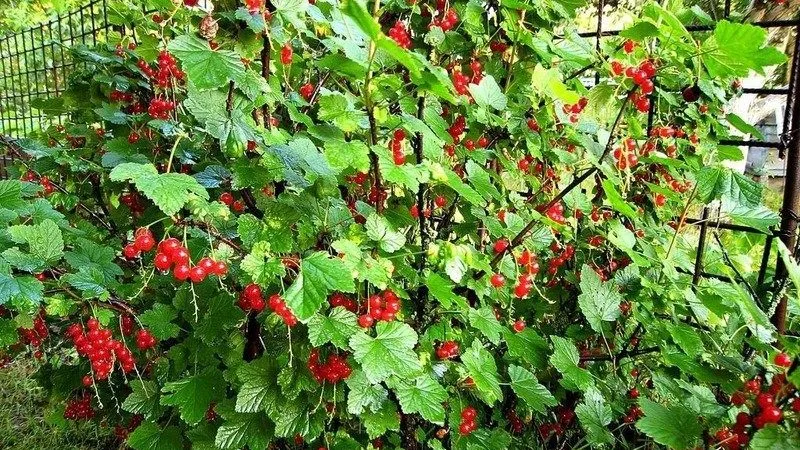
Common challenges and solutions:
- Avoid over-pruning—remove only old, diseased, or overcrowded growth.
- In July–August, sap flow is high; seal large cuts with grafting wax.
- For red/white currants, retain 2–3-year-old shoots—they branch naturally.
- Maintain 9–12 healthy branches (1–3 years old) per bush for optimal yields.
- Mid-summer, feed with organic matter: 1 L manure per 10 L water or 0.5 L poultry manure steeped in 10 L water. Apply 2–3 buckets per bush.
- For efficient watering, time how long it takes to fill a bucket with your hose. Multiply by the number of buckets needed per bush (e.g., 1 minute per bucket × 5 buckets = 5 minutes per plant). Use low pressure for better absorption.
Conclusion
Summer pruning occurs after harvest. Timing varies: southern Europe (June–July), northern/central regions (August). Red/white currants are pruned in September.
Use sharp, sanitized tools to remove old, diseased, or excess growth. Follow up with watering, phosphorus-potassium fertilizers, and moderate nitrogen. Proper care ensures healthy, productive bushes.







